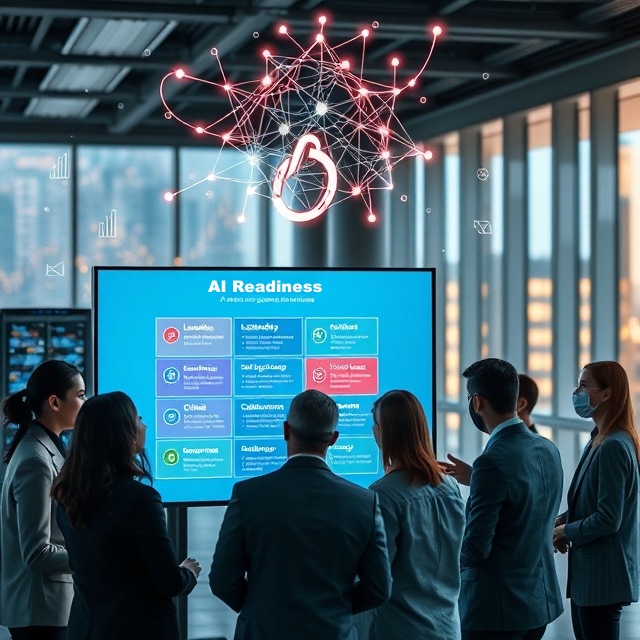Artificial Intelligence (AI) has emerged as a transformative technology, reshaping industries, and economies across the globe. Its potential to streamline processes, optimize decision-making, and create new opportunities is unparalleled. As organizations recognize the significance of AI adoption, evaluating their AI readiness becomes a crucial endeavor. Organizations that harness the power of AI can gain a competitive edge in the digital age. The readiness of an organization to embrace AI is a critical determinant of its success in this evolving landscape.
AI readiness refers to an organization’s preparedness to effectively adopt, implement, and leverage AI technologies. It encompasses technological, cultural, and strategic dimensions that together determine an organization’s capacity to harness AI’s potential.
There are eight (8) key components of AI readiness that can be evaluated in an organization.
- First is leadership vision and commitment to AI adoption. These set the tone for the entire organization, as leaders must understand the transformative potential of AI, allocate resources, and actively champion its integration.
- Second is data infrastructure and quality. Since AI thrives on data, organizations need a robust infrastructure to collect, store, and manage data. Moreover, data quality is paramount; accurate, relevant, and diverse data is essential for training and refining AI models.
- Third is technical expertise. Organizations should have skilled data scientists, machine learning engineers, and AI developers who can build and deploy AI solutions effectively.
- Fourth s cultural openness to change: AI adoption often requires a cultural shift. Organizations must be open to change, encouraging innovation, experimentation, and a willingness to embrace new technologies.
- Fifth is ethical and regulatory awareness: As AI usage grows, ethical considerations and regulatory compliance become critical. Organizations should be prepared to address issues related to bias, privacy, and transparency.
- Sixth is resource allocation. As AI initiatives require investment, adequate budget allocation for technology, talent acquisition, and training is indicative of an organization’s commitment to AI readiness.
- Seventh is collaboration and integration. Because AI seldom operates in isolation, integration with existing systems and collaboration between departments are necessary for seamless AI implementation.
- Lastly, a well-defined strategy for managing the changes AI brings is essential. This includes communication, training, and support to ensure a smooth transition for employees.
These key components form part of a systematic approach to evaluate AI readiness of an organization.
As a start, organizations should conduct an internal assessment. This involves evaluating their existing technological infrastructure, data capabilities, talent pool, and overall strategic alignment with AI adoption.
Benchmarking against industry peers also helps gauge where an organization stands in terms of AI adoption. This can provide insights into best practices and areas that need improvement.
Seeking input from AI experts or consultants can likewise provide an objective assessment. They can evaluate an organization’s technological capabilities, data readiness, and strategic alignment.
From these foregoing steps, gaps can be identified between the current state and desired AI readiness. This could involve analyzing where the organization falls short in terms of data quality, talent availability, leadership commitment, or other key components.
Then running small-scale pilot AI projects will allow organizations to assess their capabilities in a controlled environment. These projects can highlight challenges and provide valuable learning experiences.
Learning from these small-scale projects shall be the basis for continuous improvement. Organizations should establish a feedback loop where lessons learned from pilot projects and initial AI initiatives inform the refinement of their AI readiness strategy.
Evaluating AI readiness offers several benefits to organizations. For one, organizations can make informed decisions about AI adoption, knowing their strengths and areas needing improvement.
Understanding AI readiness also prevents wastage of resources on initiatives that the organization is ill-prepared to execute. In addition, a comprehensive assessment identifies potential risks and allows organizations to proactively address ethical, regulatory, and technical challenges.
Being AI-ready likewise enhances an organization’s competitiveness by enabling them to leverage AI’s transformative power swiftly and effectively. Even if an organization is not fully ready for AI today, the evaluation process helps in charting a roadmap for future readiness.
The AI readiness of organizations in the Philippines is a mixed picture, with some companies leading the way while others are still navigating the complexities of AI adoption. Several challenges define the AI readiness landscape in the country.
One challenge is that many organizations in the Philippines still lack a comprehensive understanding of AI and its potential benefits, leading to reluctance in adoption. Another is that many organizations struggle with data fragmentation and inadequate infrastructure. Lastly, the shortage of skilled AI professionals in the country presents a hurdle for organizations looking to develop and implement AI solutions.
As AI continues to reshape industries, organizations must assess their readiness to harness its potential. Evaluating AI readiness involves a holistic approach, encompassing leadership commitment, technological infrastructure, data quality, talent, culture, ethics, and strategy. Through a systematic evaluation, organizations can position themselves to navigate the complexities of AI adoption, drive innovation, and secure a competitive edge in an increasingly AI-driven world.
Tag/s:Artificial IntelligenceBusiness TransformationReadiness






The feedback loop Rey talks about makes so much sense. Many managers concede that they rarely review how programmes are performing – this phase needs to be built in as part of the initiative.